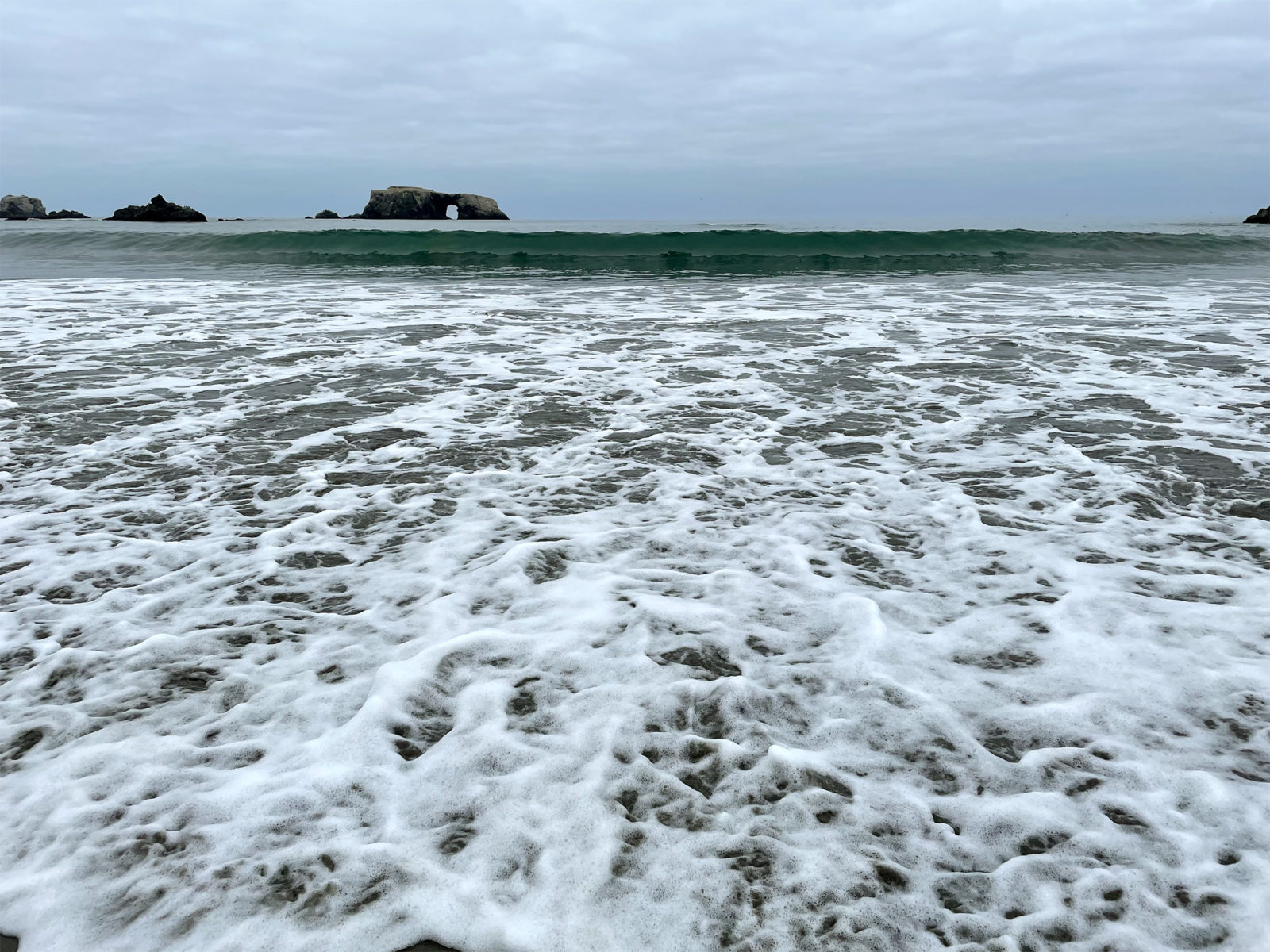On certain steep beaches along our coastline, the ocean sometimes sneaks up on the land. Even a careful observer, who watches over the course of two or five minutes to find a dry spot to set down her picnic basket, will see no signs in the sets of waves that roll in and out, six or seven at a time. A sneaker wave is bigger than its peers—scientists define it as at least two and a half times bigger—and may reach up to our picnicker’s waist, more than enough to sweep her away. It does not break but runs up the beach with its full, dangerous force. It may run all the way up the sand, hundreds of feet past where previous waves had wet the sand. It may carry logs or be heavy with silt. Our picnicker has about fifteen seconds to get away from a sneaker wave. But if the beach is backed by cliffs or rocks, as many of our Bay Area beaches are, there may be no escape.
“If you’ve ever been down to the ocean when there are 25-foot waves—nobody dies on those days,” says Troy Nicolini, the meteorologist-in-charge at the Eureka office of the National Weather Service. The agency issued an alert about possible sneaker waves from Big Sur to Sonoma earlier this week. Big waves like that scare people away; sneaker waves are more insidious. Along the coastline from central California through Oregon, sneaker waves kill about five people a year, Nicolini estimates. Last year was bad: at least 12 people were swept away by waves, in eight incidents from Blind Beach west of Santa Rosa, down to Pescadero State Beach. Eight of these people died, including a father and his two children. In 2011, a sneaker came through the Mavericks surf competition and injured a dozen people. Deaths that happen in ones and twos may not always make the news.
The unpredictability of these waves makes them tricky to study. Tuba Özkan-Haller, an Oregon State University professor, is among the wave scientists who are trying to save people from sneaker waves by understanding them better, and recently, they’ve made some headway.
But first, a splash of wave physics. Ocean waves come in different sizes, from the tiniest capillaries on the surface to the planetary tides that course across our planet twice a day or so. The wave sets that surfers watch for are called gravity waves (because gravity is the “restoring mechanism” that eventually settles them down). The sneakers that Özkan-Haller studies are a kind of wave that underlies each of these sets: “infragravity waves.” Only a few infragravity waves have sneaker potential.

The generation of a sneaker wave is “a Goldilocks thing,” Özkan-Haller says—various conditions must align for it to appear. In a normal, non-sneaky set of gravity waves, the peaks may be, say, 10 seconds apart, and the infragravity wave along the whole six-wave set will thus be a minute. But every so often, we West Coasters get much longer gravity waves from a faraway storm, whether in the South Pacific or Alaska. They are not necessarily big waves, but surfers like them, because they make the “beautiful crests, arriving predictably,” Özkan-Haller says. If these gravity waves are 25 seconds apart instead of the more usual 10, the infragravity waves underlying them will be correspondingly longer—and conditions are then ripe for them to become sneaker waves.
How dangerous a wave can become also depends on the shape of land it meets at each stage of its approach. A long shallow shelf, like much of the East Coast, will dissipate the wave’s energy, leaving it toothless and beaches much safer. But on the West Coast, the coast’s abrupt drop-offs give long waves an opportunity to come in at force. Once they get to the surf zone, a mild slope helps them pick up energy. And then right at the beach, a steeper slope is the most dangerous, because the waves don’t have far to go to “where a person in their boots and coat would be standing,” Özkan-Haller says. (A boots and coat are especially unhelpful, inside a wave.)
The sets of waves you see break, losing their energy. The longer infragravity waves, which they’ve created, don’t, Özkan-Haller says. “They just run up the beach like a tide would. They don’t lose their energy.” And they bring it all the way to the shore.
Not every beach gets sneakers. The most susceptible ones have steep slopes that face northwest and get the brunt of Alaska storms, Nicolini says. (Such beaches also often have coarse sand, which is harder to stand up in if you get caught.) There are beaches in northern California that “are so deadly I would never take a child to them,” he says. But most fatalities happen at those that are physically dangerous and also heavily visited, like San Francisco’s Ocean Beach. Last year people were swept away at McClures Beach in Pt. Reyes, at the Point Bonita Lighthouse, Pacifica’s municipal pier and Linda Mar Beach, Ross Cove at Pillar Point and Cowell Ranch Beach, as well as Blind Beach and Pescadero.
Recently, one of Özkan-Haller’s graduate students made a breakthrough while poking around on YouTube for wave videos.
To study these waves, scientists like Özkan-Haller train cameras on the coastline, and then use computers to find the needle-in-haystack sneakers in the piles of footage. Or they model wave conditions mathematically, and run simulations to test their hypotheses. In the lab at Oregon State, Özkan-Haller uses a wave tank the length of a football field to generate artificial swells under controlled conditions. But recently, one of Özkan-Haller’s graduate students, Chuan Li, made a breakthrough while poking around on YouTube for wave videos.
For January 16, 2016, the National Weather Service had a single report of a sneaker wave in its hazard database, meaning one person had required an intervention. But up and down the coast, from Humboldt Bay in California to beaches in Washington State, people had uploaded videos of waves from that day that swept beachgoers off their feet, all within five hours of each other, Özkan-Haller says. In one of them, the water swept beyond the beach and up the street. Another trapped beachgoers in front of some bluffs, in knee-deep water. Another submerged a police car completely while the police officer was trying to drive away.
Özkan-Haller and her students investigated the event forensically, measuring waves’ height and timing in the videos, confirming them with real-world measurements, interviewing witnesses. The sneaker wave had even triggered the tsunami warning system on its way back out to the ocean. Their analysis made clear how the character of the gravity waves—the set waves—had created such a large infragravity wave. The videos looked almost “like a tsunami, in the sense that it feels like the water just keeps on coming and coming and coming and coming,” she says, “And you’re thinking it’s going to turn back around—but no, it keeps on coming.”
Özkan-Haller is working toward being able to forecast sneakers like we do rain, with highly localized probabilities. Wave scientists are not all that close to being able to predict every wave in nature like they can in the tank. It is just a very, very complex system. But the science is getting there. “We will save lives,” she says.
Until then, here’s how to avoid sneaker waves: First, pick the right beach for a picnic. The wrong beaches are northwest-facing with steepish slopes, especially in the winter. Check for National Weather Service alerts. Watch surfers and learn from them—where there are long-period wave sets, there are infragravity waves and potential sneakers; surfers will float farther out from shore to catch the bigger waves in these conditions. On the beach, do not consider any part of the sand safe. Do not approach the water unless you have a reason, like perch-fishing (with a life vest) or surfing (in a wetsuit). Watch the water. Have an exit plan that you can implement in under 15 seconds. If your dog runs into the ocean, do not run in to rescue it—people have died doing so, and dogs are physiologically better equipped to handle cold water than we are. And do not be lulled to complacency by a sense that these waves are rare. “If you think they’re freakishly uncommon, you think there’s nothing you can do,” Nicolini says. “They’re happening all the time.”



